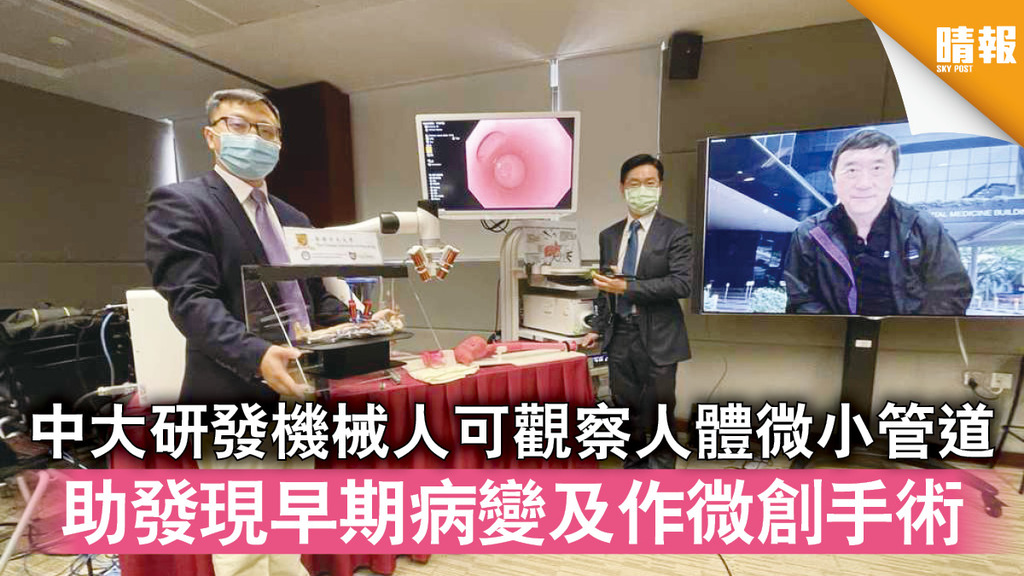人體內的器官如膽、胰臟及泌尿系統等有較小分支,現有常規技術如「內窺鏡」等未能觀察這些部位,難以及早測出病變。中大早前成功研發以幹細胞為基礎的「生物合成軟體微型機械人」,利用磁力導航系統等將機械人送進狹窄及曲折管道及移動,未來有望應用於人體檢測及微創治療。
{{hket:inline-image name="7a17db1f-e5e2-4107-8ba9-c878c29aeb9a.jpg"}}{{/hket:inline-image}}
目前內窺鏡等常規觀察技術有何限制?
- 難鑽進體內彎曲管道
- 一般觀察到約9毫米窄已是極限
- 人體器官愈深入,其枝葉愈窄小,憑現時技術難以觀察
- 一旦有膽管阻塞等早期疾病,現有技術未必可發現
資料來源:中大醫學院周毓浩創新醫學技術中心主任趙偉仁
中大機械與自動化工程學系教授張立稱,是次研究為納米技術儀器進入人體後衍生的控制問題及排斥反應帶來突破。他解釋,人體的免疫系統會攻擊外來物,遂以約98%源於宿主的幹細胞包裹着該款柔軟度高、具彈性的微型機械人,可降低體內排斥反應。其餘約2%則為微量磁性粒子,以作磁場驅動,精準傳輸到目標位置。
研究亦利用「雙模成像內鏡輔助磁驅動系統」(EMADIS)建立「快速通道」,助機械人避過體內生物屏障等,以增加移動速度,約8分鐘即可在複雜體內移動1米。
張續說,正計劃2年內展開動物模型研究,料會先用豬隻作試驗。趙偉仁估計,微型機械人有很多潛在可能性,包括若進入膽管微細管道成像扭曲,或反映有膽管阻塞問題;若可發展至具載藥能力,可比現時標靶藥更準確處理癌細胞。
放大即睇教授示範操作儀器:
- {{hket:inline-image name="skypost.jpg"}}{{/hket:inline-image}}
- {{hket:inline-image name="1e7dfe01-3e12-4919-9b7d-104e77496166.jpg"}}{{/hket:inline-image}}
- {{hket:inline-image name="1200a7c5-5379-4d6a-8940-71900498e13c.jpg"}}{{/hket:inline-image}}
- {{hket:inline-image name="c3ad7ebd-b87d-4d4e-abc9-f9a3a9448dc1.jpg"}}{{/hket:inline-image}}
- {{hket:inline-image name="3c0283a3-0abb-49da-b4ff-5feaf6fd26f6.jpg"}}{{/hket:inline-image}}
- {{hket:inline-image name="S.jpg"}}{{/hket:inline-image}}
- {{hket:inline-image name="46b192a1-a055-4f49-a0e5-eb6e2d00467c.jpg"}}{{/hket:inline-image}}
- {{hket:inline-image name="fcd24752-0dbf-4bcd-b5a7-04b6dd776d2d.jpg"}}{{/hket:inline-image}}
- {{hket:inline-image name="aeec5c23-2e11-4b64-bdde-de885eef6f67.jpg"}}{{/hket:inline-image}}
撰文:李嘉慧
責任編輯:蔡少紋
-
-
| 體育新聞主播丨伍晃榮離世16周年墳墓將要「移民」 昔日徒弟馮堅成伍家謙撰文懷緬 |
|
-
| 何超欣曬E Cup逼爆上圍激似利智 賭王何鴻燊最美千金氣質別樹一幟 |
|
-
| MIRROR馬來西亞演唱會突然取消 鏡仔戀愛狀況公開Ian爆有人將封盤 |
|
-
| 俞琤70歲大壽丨倪震快將登六激罕同周慧敏合體 留鬚Look意外撞樣黃劍文? |
|
-
| 蘇寧生活家電展|電視雪櫃冷氣低至42折 舊電器換新可減$800 享免費回收再送禮品 |
|
-
| 保單逆按自製長糧 | 充裕退休儲備 + 保障家人GET!(附個案說明) |
|
-
-
-
| 胸悶、頭脹、手腳麻痺?黃祥興不靠藥物 1個月拆走血管炸彈 重拾醒神健康 |
|
-
| 私密處痕癢、灼痛、異味來襲 Grace教路:每日1粒解決「私密」問題 |
|
-
-
| 唔止面黃 生痘痘 長期攰都可能肝損傷 黃祥興逆轉肝機能 慶幸及早護肝 |
|
-
您也可能喜歡...
-
|
新冠肺炎|中大研鼻紙條取樣減不適 準確度高幼童嬰兒適用
|
-
|
快速檢測│中大研機械人測病菌 15分鐘完成費用平8成
|
-
|
食物敏感│中大研究指港人常吃鯇魚較易致敏 嚴重或有生命危險
|
-
|
中大研究 | 手提心臟超聲波掃描器 篩查胸主動脈瘤準確度達9成
|
-
|
精神健康|中大牛津VR合作 研虛擬實境改善社交迴避
|
-
|
中大研究 | 炎症性腸病新症10年多30倍 增腸道惡菌食物添加劑成元兇
|
-
|
男人最痛|浸大中大研發「精胺風險評分」 免卻入侵活檢診斷前列腺癌
|
創新科技|中大研發機械人可觀察人體微小管道 助發現早期病變及作微創手術 - 晴報 - 時事 - 要聞 - D210408
創新科技|中大研發機械人可觀察人體微小管道 助發現早期病變及作微創手術 - 晴報 - 時事 - 要聞
人體內的器官如膽、胰臟及泌尿系統等有較小分支,現有常規技術如「內窺鏡」等未能觀察這些部位,難以及早測出病變。中大早前成功研發以幹細胞為基礎的「生物合成軟體微型機械人」,利用磁力導航系統等將機械人送進狹
https%3A%2F%2Fskypost.hk%2Farticle%2F2926475%2F%E5%89%B5%E6%96%B0%E7%A7%91%E6%8A%80%EF%BD%9C%E4%B8%AD%E5%A4%A7%E7%A0%94%E7%99%BC%E6%A9%9F%E6%A2%B0%E4%BA%BA%E5%8F%AF%E8%A7%80%E5%AF%9F%E4%BA%BA%E9%AB%94%E5%BE%AE%E5%B0%8F%E7%AE%A1%E9%81%93%20%E5%8A%A9%E7%99%BC%E7%8F%BE%E6%97%A9%E6%9C%9F%E7%97%85%E8%AE%8A%E5%8F%8A%E4%BD%9C%E5%BE%AE%E5%89%B5%E6%89%8B%E8%A1%93
https://skypost.hk/article/2926475/創新科技-中大研發機械人可觀察人體微小管道-助發現早期病變及作微創手術
https://resource01-proxy.ulifestyle.com.hk/res/v3/image/content/2925000/2926475/20210419OG-W004_1024.jpg
https://resource01-proxy.ulifestyle.com.hk/res/v3/image/content/2925000/2926475/
時事
要聞
503
2926475
514
503001001
時事 要聞
手術,治療,創新科技及應用,標靶藥,工程,導航,機械人
健康醫療,治療,手術,健康醫療,治療,科技通訊,創新科技及應用,實體詞,藥物種類及名稱,標靶藥,實體詞,工種,工程,實體詞,IT技術,導航,實體詞,科技硬件,機械人
技術 機械人 系統 人體 趙偉仁 中大 生物 幹細胞 管道 機械 醫學 膽管 工程 中心 主任 張立稱 學系 醫學院 器官 周毓浩 常規 反應 能力 標靶藥 癌細胞 磁性 粒子 磁場 目標 位置
2021-04-08
創新科技-中大研發機械人可觀察人體微小管道-助發現早期病變及作微創手術

